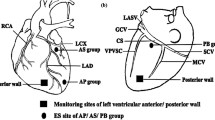Abstract
Electrical stimulation of the rostal cerebellar fastigial nucleus (FNS) has been proved to have neuroprotective effects, but it is not known whether FNS also has a cardioprotective effect. One hundred Sprague-Dawley rats were randomly allocated into four groups, including a sham-operation group (Sham group), rats whose coronary arteries were ligated but the FNs were sham stimulated (AMI group), rats in which both coronary arteries were ligated and FNs were stimulated (FNS group), and rats whose fastigial nuclei were lesioned 5 days before ligation, then their coronary arteries were ligated and FNs were stimulated (FNL group). Heart rate variability parameters were monitored 6 h, 24 h, 7 days and 21 days after ligation, and mortality rates, hemodynamic parameters and infarction sizes were compared after 21 days. FNS improved the survival of rats, and this may be due to the increased vagal and decreased sympathetic tone. FN stimulation does not affect infarction size and hemodynamic parameters. FN stimulation may have a protective effect on surgically induced myocardial infarction rats.







Similar content being viewed by others
References
Filipovic M, Jeger R, Probst C (2003) Heart rate variability and cardiac troponin I are incremental and independent predictors of one-year all-cause mortality after major noncardiac surgery in patients at risk of coronary artery disease. J Am Coll Cardiol 42:1767–1776
Dekker JM, Crow RS, Folsom AR, Hannan PJ, Liao D, Swenne CA, Schouten EG (2000) Low heart rate variability in a 2-minute rhythm strip predicts risk of coronary heart disease and mortality from several causes: the ARIC Study. Atherosclerosis risk in communities. Circulation 102:1239–1244
Sandrone G, Mortara A, Torzillo D, La Rovere MT, Malliani A, Lombardi F (1994) Effects of beta blockers (atenolol or metoprolol) on heart rate variability after acute myocardial infarction. Am J Cardiol 74:340–345
Bonaduce D, Marciano F, Petretta M, Migaux ML, Morgano G, Bianchi V, Salemme L, Valva G, Condorelli M (1994) Effects of converting enzyme inhibition on heart period variability in patients with acute myocardial infarction. Circulation 90:108–113
Golanov EV, Reis DJ (1996) Cerebral cortical neurons with activity linked to central neurogenic spontaneous and evoked elevations in cerebral blood flow. Neurosci Lett 209:101–104
Yamamoto S, Golanov EV, Reis DJ (1993) Reductions in focal ischemic infarctions elicited from cerebellar fastigial nucleus do not result from elevations in cerebral blood flow. J Cereb Blood Flow Metab 13:1020–1024
Glickstein SB, Golanov EV, Reis DJ (1999) Intrinsic neurons of fastigial nucleus mediate neurogenic neuroprotection against excitotoxic and ischemic neuronal injury in rat. J Neurosci 19:4142–4154
Reis DJ, Golanov EV, Galea E, Feinstein DL (1997) Central neurogenic neuroprotection: central neural systems that protect the brain from hypoxia and ischemia. Ann N Y Acad Sci 835:168–186
Maclean D, Fishbein MC, Maroko PR, Braunwald E (1976) Hyaluronidase-induced reductions in myocardial infarct size. Science 194(4261):199–200
Pfeffer JM, Pfeffer MA, Braunwald E (1985) Influence of chronic captopril therapy on the infarcted left ventricle of the rat. Circ Res 57:84–95
Paxinos G, Watson C (1986) The rat brain in stereotaxic coordinates. Academic Press, Sydney, pp 7–84
Singer DH, Martin GJ, Magid N, Weiss JS, Schaad JW, Kehoe R, Zheutlin T, Fintel DJ, Hsieh AM, Lesch M (1988) Low heart rate variability and sudden cardiac death. J Electrocardiol 21(Suppl):S46–S55
Ushiyama T, Mizushige K, Wakabayashi H (2008) Analysis of heart rate variability as an index of noncardiac surgical stress. Heart Vessels 23:53–59
Kontopoulos AG, Athyros VG, Papageorgiou AA, Boudoulas H (1999) Effect of quinapril or metoprolol on circadian sympathetic and parasympathetic modulation after acute myocardial infarction. Am J Cardiol 84:1164–1169
Achari NK, Downman CB (1970) Autonomic effector responses to stimulation of nucleus fastigius. J Physiol 210:637–650
Bradley DJ, Pascoe JP, Paton JF, Spyer KM (1987) Cardiovascular and respiratory responses evoked from the posterior cerebellar cortex and fastigial nucleus in the cat. J Physiol 393:107–121
Dormer KJ, Foreman RD, Ohata CA (1982) Fastigial nucleus stimulation and excitatory spinal sympathetic activity in dog. Am J Physiol 243:R25–R33
Bradley DJ, Paton JF, Spyer KM (1987) Cardiovascular responses evoked from the fastigial region of the cerebellum in anaesthetized and decerebrate rabbits. J Physiol 392:475–491
Del Bo A, Sved AF, Reis DJ (1984) Fastigial nucleus stimulation and concurrent activation of cardiovascular receptors; differentiate effects on arterial pressure, heart rate and vasopressin release. J Hypertens suppl 2:S49–S51
Deitrichs E (1985) Divergent axon collaterals to cerebellum and amygdala from neurons in the parabrachial nucleus locus coeruleus and some adjacent nuclei: a fluorescent double labeling study using rhodamine labeled latex microspheres and fast blue as retrograde tracers. Anat Embryol 172:75–82
Deitrichs E, Haines DE (1985) Observations on the cerebellohypothalamic projection, with comments on non-somatic cerebellar circuits. Arch Ital Biol 123:133–139
Dietrichs E, Haines DE, Røste GK, Røste LS (1994) Hypothalamocerebellar and cerebellohypothalamic projections: circuits for regulating nonsomatic cerebellar activity? Histol Histopathol 9:603–614
Ruggiero DA, Anwar M, Golanov EV, Reis DJ (1997) The pedunculopontine tegmental nucleus issues collaterals to the fastigial nucleus and rostral ventrolateral reticular nucleus in the rat. J Brain Res 760:272–276
Acknowledgment
This study was supported by the National Natural Science Foundation of China (no. 30571780).
Author information
Authors and Affiliations
Corresponding author
Rights and permissions
About this article
Cite this article
Abulaiti, A., Hu, D., Zhu, D. et al. Influence of fastigial nucleus stimulation on heart rate variability of surgically induced myocardial infarction rats: fastigial nucleus stimulation and autonomous nerve activity. Heart Vessels 26, 654–662 (2011). https://doi.org/10.1007/s00380-010-0108-y
Received:
Accepted:
Published:
Issue Date:
DOI: https://doi.org/10.1007/s00380-010-0108-y




